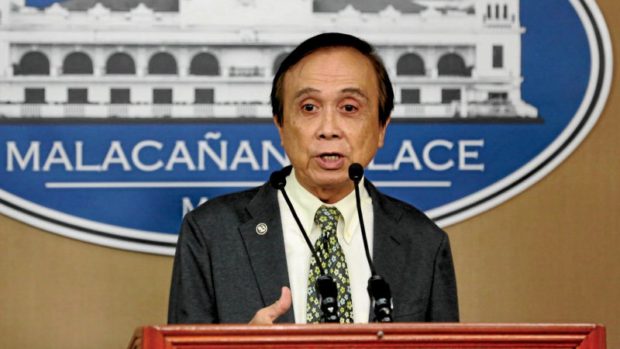Economy grows 6.7% amid BPO slowdown

Socioeconomic Planning Secretary Ernesto M. Pernia (File photo by JOAN BONDOC / Philippine Daily Inquirer)
The Philippine economy, as measured by the gross domestic product (GDP), grew 6.7 percent in 2017, among the fastest in the region despite a slowdown in the business process outsourcing (BPO) industry.
In the fourth quarter, GDP grew at a slower rate of 6.6 percent, a pace similar to that a year ago but slower than the 7-percent expansion in the third quarter.
GDP, the total value of goods produced and services rendered in a given period, does not measure well-being or inequality.
The economy grew last year, though slower than the 6.9 percent posted in 2016, even as more Filipinos said they experienced hunger last December, indicating that the benefits of economic expansion did not trickle down to the poor. (See story on Page A3.)
News of the GDP expansion also came in the wake of an Oxfam report that the richest 1 percent cornered 82 percent of the wealth generated in 2017, while the poorest half of humanity got nothing.
Socioeconomic Planning Secretary Ernesto M. Pernia said the GDP growth last year was the fastest in the region after China’s 6.9 percent and Vietnam’s 6.8 percent.
“The [growth] was good but lower than expectations,” said Jonathan Ravelas, chief strategist at the country’s leading lender BDO Unibank.
Ravelas, however, said “the recovery in consumption and further improvement in government spending highlighted the underlying strength of the economy.”
Growth slightly slowed last year in the absence of election-related spending that boosted growth in 2016, according to Pernia.
He noted that GDP growth rates in 2005 and 2011—both postelection years—dove deeper to 4.8 percent from 6.7 percent in 2004 and to 3.7 percent from 7.6 percent in 2010, respectively.
“You can see that our decline is really very moderate at 0.2 percent of 1 percentage point,” he said.
Pernia acknowledged that the BPO industry, worth $23 billion and employing 1.15 million people, was a “major contributing factor to this decline.”
The sector, which has become a major pillar of the Philippine economy, includes call centers and offices that carry out such functions for overseas companies as accounting, medical and legal transcription, software design, animation and even architecture.
Growth drivers
Industry officials said investment fell 31.3 percent year-on-year in the three months to last June, with threats by US President Donald Trump to bring back jobs outsourced abroad cited as a key factor.
There was also concern in the Philippines that automation and artificial intelligence could eventually steal call-center jobs.
National Statistician Lisa Grace S. Bersales said manufacturing, trade, as well as real estate, renting and business activities were the growth drivers in the fourth quarter.
From October to December, the industry sector grew 7.3 percent year-on-year; services, 6.8 percent; and agriculture, 2.4 percent, reversing the 1.3-percent decline in the same three-month period in 2016, Bersales said.
Services contributed 3.9 percentage points to total GDP growth; industry, 2.5 percentage points; and agriculture, 0.3 percentage point, Bersales said on Tuesday.
In the fourth quarter, robust government spending on public goods and services as well as double-digit growth in external merchandise trade sustained the economic expansion—the 10th straight quarter that GDP growth was above 6 percent.
Exports
“Growth in the fourth quarter was backed by robust growth of 14.3 percent in public spending — that was really the main driver, public spending — which was an increase from 4.5 percent in the previous year,” Bersales said.
On the expenditure side, Pernia said external demand improved with growth in exports of goods bouncing back to 20.2 percent from 17.2 percent in the third quarter, offsetting the services exports sector’s slowdown to 12.6 percent from 19.9 percent.
Pernia said domestic demand growth strengthened to 7.3 percent in the fourth quarter from 6.4 percent in the third.
He said fixed investments accelerated to 9.3 percent with growth in durable equipment improving to more than 12.1 percent, indicating businesses’ continued confidence in the long-term prospects of the economy.
In line with the “Build, Build, Build” infrastructure program, public construction spending jumped by a fourth in the last quarter, according to Pernia.
Slowing capital formation
April Lynn Lee-Tan, head of research at leading online stock brokerage COL Financial, said growth decelerated in the fourth quarter due to the slower increase in capital formation or investments.
In a research note, Tan noted that growth in capital formation reached 8.2 percent year-on-year in the fourth quarter, down from 8.7 percent in the third, bringing full-year capital formation growth to 9 percent, down from 23.7 percent in 2016.
This was in turn attributed to the significant drop in private sector construction growth to 3.3 percent in 2017 from 11.5 percent in 2016. —With a report from AFP

